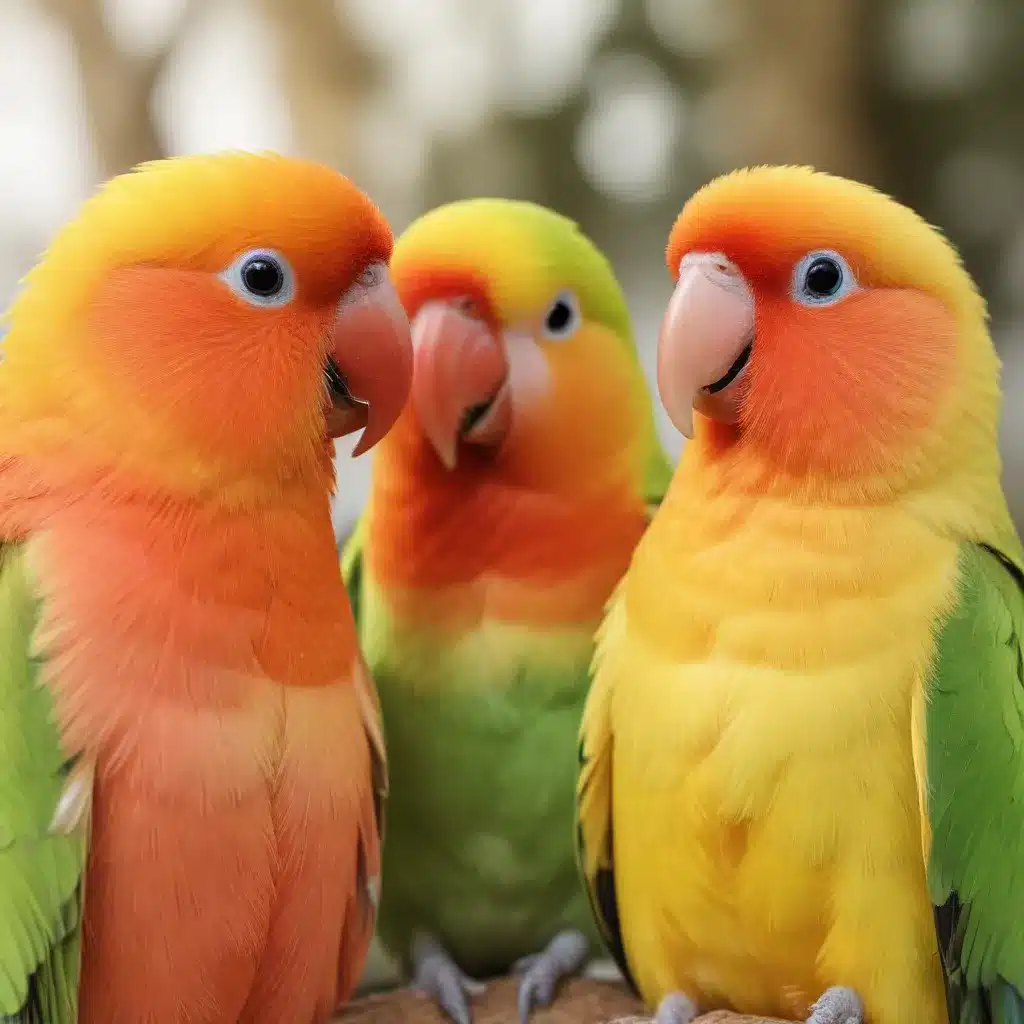
Avian Companions
Lovebirds are a delightful genus of small parrots known for their playful personalities and deep bonds with their caretakers. As experienced avian experts, we understand the joy and responsibility that comes with caring for these charming feathered friends. In this comprehensive guide, we’ll explore a variety of engaging activities and environmental enrichment to help your lovebirds thrive and enjoy a fulfilling, relaxed lifestyle.
Lovebird Characteristics
Lovebirds are compact, stocky birds with short, rounded tails and distinctive hooked beaks. These vibrant creatures come in a rainbow of colors, from the classic green and blue mutations to the stunning peach-faced and Fischer’s varieties. What truly sets lovebirds apart, however, is their unwavering affection and loyalty towards their bonded partners, both human and avian.
Lovebird Care
Providing a stimulating, comfortable, and secure environment is essential for the well-being of your lovebird companions. These social birds require a spacious cage or aviary with plenty of perches, hiding spots, and opportunities for climbing and foraging. A balanced, nutrient-rich diet of high-quality pellets, fresh fruits and vegetables, and occasional treats will ensure your lovebirds maintain optimal health.
Lovebird Behaviors
Lovebirds are known for their playful and energetic nature. They often engage in playful antics, such as chasing, beak fencing, and even wing-flapping dances. Understanding their natural behaviors and body language is key to interpreting their needs and providing the appropriate enrichment and interactions.
Relaxing Activities
Keeping your lovebirds mentally and physically stimulated is crucial for their overall well-being. By incorporating a variety of relaxing activities into their daily routine, you can help them thrive and foster a strong bond with you.
Enrichment Ideas
Lovebirds are intelligent birds that crave mental and physical stimulation. Providing a diverse array of toys, foraging opportunities, and novel experiences can help prevent boredom and promote natural behaviors. Consider incorporating puzzles, shredding materials, and rotating toys to keep your lovebirds engaged and entertained.
Environmental Considerations
Ensuring your lovebirds’ habitat is comfortable, secure, and tailored to their needs is essential for their relaxation and well-being. Optimize lighting, temperature, and ventilation to create a soothing environment. Incorporate natural elements, such as live plants and perches, to mimic their native habitats and encourage natural behaviors.
Interactive Playtime
Engaging in interactive playtime with your lovebirds is a fantastic way to bond and provide mental stimulation. Spend time each day offering positive reinforcement training, gentle handling, and supervised out-of-cage exploration. These activities not only strengthen the human-avian bond but also help your lovebirds feel safe, secure, and relaxed.
Aviary Design
Designing a suitable habitat for your lovebirds is crucial for their overall well-being and relaxation. By considering their specific needs and preferences, you can create an environment that promotes a stress-free and enriched lifestyle.
Habitat Requirements
Lovebirds require a spacious enclosure, ideally an aviary or a large cage, to accommodate their active nature and need for flight. The minimum recommended size for a single lovebird is 24 inches by 24 inches by 24 inches, but larger is always better. Ensure the enclosure is equipped with a variety of perches, both horizontal and vertical, to encourage natural climbing and resting behaviors.
Decor and Furnishings
Decorating your lovebirds’ habitat with natural elements, such as branches, logs, and live plants, can create a visually appealing and relaxing environment. Incorporate nesting materials, such as shredded paper or soft, natural fibers, to allow your lovebirds to engage in their innate nest-building behaviors. Strategically placed hiding spots and cozy nooks can provide your birds with a sense of security and comfort.
Ventilation and Lighting
Proper ventilation and lighting are essential for your lovebirds’ overall well-being and relaxation. Ensure the enclosure is well-ventilated to maintain air quality and prevent the buildup of harmful fumes or odors. Provide a balanced lighting schedule that mimics their natural day-night cycles, with a combination of natural and artificial light sources.
Affectionate Interactions
Fostering a strong bond and understanding with your lovebirds is crucial for their relaxation and overall happiness. By engaging in positive interactions and learning their unique communication cues, you can create a harmonious and fulfilling relationship.
Bonding Techniques
Spend time each day engaging in gentle handling, positive reinforcement training, and supervised out-of-cage exploration with your lovebirds. These activities not only strengthen the human-avian bond but also help your lovebirds feel safe, secure, and relaxed. Offer your lovebirds treats by hand and provide opportunities for them to perch on your finger or shoulder, further reinforcing their trust and affection.
Training Approaches
Positive reinforcement training is an excellent way to build trust, enhance communication, and promote relaxation in your lovebirds. Start with simple commands, such as “step up” or “come,” and use a clicker or verbal praise to reinforce desired behaviors. This not only strengthens the bond between you and your birds but also provides mental stimulation and a sense of security.
Communicative Cues
Observing and understanding your lovebirds’ body language and vocalizations is crucial for interpreting their needs and emotions. Familiarize yourself with their various calls, from the cheerful chirps to the contented soft trills, to better gauge their mood and respond accordingly. Pay attention to their posture, feather positioning, and eye contact to gain insights into their comfort level and willingness to engage.
By incorporating these relaxing activities, thoughtful habitat design, and affectionate interactions, you can create a harmonious and enriched environment for your lovebird companions to thrive. Remember, every lovebird is unique, so be patient, adaptable, and attuned to their individual needs and preferences. For more information and resources, please visit Mika Birds Farm – your trusted source for avian expertise and care.


